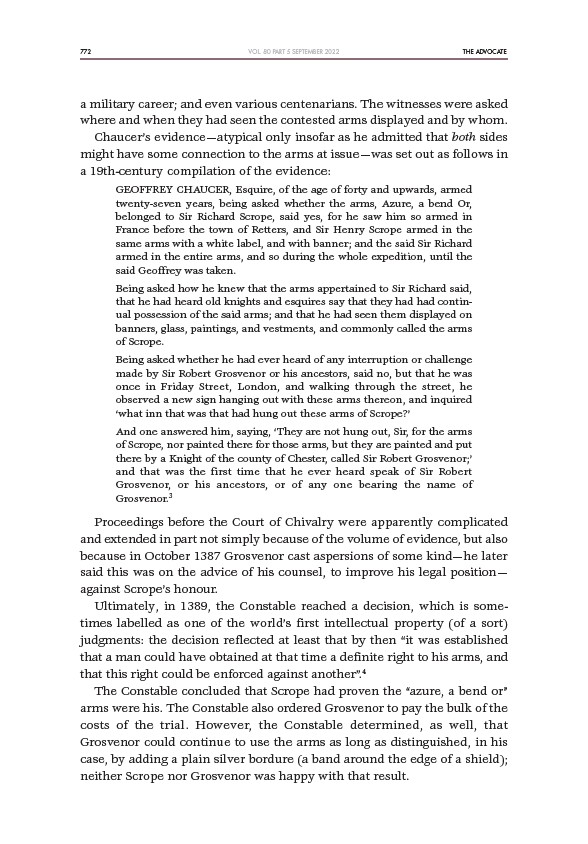
772 THE ADVOCATE
VOL. 80 PART 5 SEPTEMBER 2022
a military career; and even various centenarians. The witnesses were asked
where and when they had seen the contested arms displayed and by whom.
Chaucer’s evidence—atypical only insofar as he admitted that both sides
might have some connection to the arms at issue—was set out as follows in
a 19th-century compilation of the evidence:
GEOFFREY CHAUCER, Esquire, of the age of forty and upwards, armed
twenty-seven years, being asked whether the arms, Azure, a bend Or,
belonged to Sir Richard Scrope, said yes, for he saw him so armed in
France before the town of Retters, and Sir Henry Scrope armed in the
same arms with a white label, and with banner; and the said Sir Richard
armed in the entire arms, and so during the whole expedition, until the
said Geoffrey was taken.
Being asked how he knew that the arms appertained to Sir Richard said,
that he had heard old knights and esquires say that they had had continual
possession of the said arms; and that he had seen them displayed on
banners, glass, paintings, and vestments, and commonly called the arms
of Scrope.
Being asked whether he had ever heard of any interruption or challenge
made by Sir Robert Grosvenor or his ancestors, said no, but that he was
once in Friday Street, London, and walking through the street, he
observed a new sign hanging out with these arms thereon, and inquired
‘what inn that was that had hung out these arms of Scrope?’
And one answered him, saying, ‘They are not hung out, Sir, for the arms
of Scrope, nor painted there for those arms, but they are painted and put
there by a Knight of the county of Chester, called Sir Robert Grosvenor;’
and that was the first time that he ever heard speak of Sir Robert
Grosvenor, or his ancestors, or of any one bearing the name of
Grosvenor.3
Proceedings before the Court of Chivalry were apparently complicated
and extended in part not simply because of the volume of evidence, but also
because in October 1387 Grosvenor cast aspersions of some kind—he later
said this was on the advice of his counsel, to improve his legal position—
against Scrope’s honour.
Ultimately, in 1389, the Constable reached a decision, which is sometimes
labelled as one of the world’s first intellectual property (of a sort)
judgments: the decision reflected at least that by then “it was established
that a man could have obtained at that time a definite right to his arms, and
that this right could be enforced against another”.4
The Constable concluded that Scrope had proven the “azure, a bend or”
arms were his. The Constable also ordered Grosvenor to pay the bulk of the
costs of the trial. However, the Constable determined, as well, that
Grosvenor could continue to use the arms as long as distinguished, in his
case, by adding a plain silver bordure (a band around the edge of a shield);
neither Scrope nor Grosvenor was happy with that result.